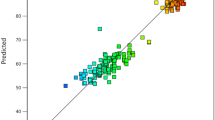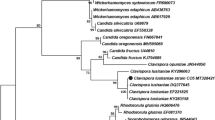Abstract
This study is aimed at assessing the ability of metal-resistant yeast, Candida tropicalis, to uptake cadmium from the liquid medium. The minimum inhibitory concentration of Cd2+ against C. tropicalis was 2,800 mg L−1. The yeast also showed tolerance towards Zn2+ (3,100 mg L−1), Ni2+ (3,000 mg L−1), Hg2+ (2,400 mg L−1), Cu2+ (2,300 mg L−1), Cr6+ (2,000 mg L−1), and Pb2+ (1,200 mg L−1). The yeast isolate showed typical growth curves, but low specific rate of growth was observed in the presence of cadmium. The yeast isolate showed optimum growth at 30°C and pH 7. The metal processing ability of the isolate was determined in a medium containing 100 mg L−1 of Cd2+. C. tropicalis could decline Cd2+ 57%, 69%, and 80% from the medium after 48, 96, and 144 h, respectively. C. tropicalis was also able to remove Cd2+ 56% and 73% from the wastewater after 6 and 12 days, respectively. Cd produced an increase in glutathione (GSH) and non-protein thiol levels by 146.15% and 59.67% at 100 mg L−1 concentration, respectively. Metal tolerance and accumulation together with changes in the GSH status and non-protein thiols under Cd exposure were studied in C. tropicalis.






Similar content being viewed by others
Explore related subjects
Discover the latest articles and news from researchers in related subjects, suggested using machine learning.References
APHA (1989). Standard methods for the examination of water and wastewater (18th ed.). Washington, DC: APHA.
Balsalobre, L., De-Siloniz, M. I., Validerrama, M. J., Benito, T., Larrea, M. T., & Peinado, J. M. (2003). Occurrence of yeasts in municipal wastes and their behaviour in presence of cadmium copper and zinc. Journal of Basic Microbiology, 43, 185–193. doi:10.1002/jobm.200390021.
Benson, H. J. (1994). Microbiological applications. Laboratory manual in general microbiology. Dubuque: Wan C. Brown.
Berdicevsky, I., Lea, D., Marzbach, D., & Yannai, S. (1993). Susceptibility of different yeast species to environmental toxic metals. Environmental Pollution, 80, 41–44. doi:10.1016/0269-7491(93)90007-B.
Chipasa, K. B. (2003). Accumulation and fate of selected heavy metals in a biological wastewater treatment system. Waste Management (New York, N.Y.), 23, 135–143. doi:10.1016/S0956-053X(02)00065-X.
Chisti, Y. (2004). Environmental impact of toxic pollutants. Biotechnology Advances, 6, 431–432. doi:10.1016/j.biotechadv.2003.12.004.
Coeurdassier, M., Devaufleury, A., Scheifler, R., Morhain, E., & Badot, P. M. (2004). Effects of cadmium on the survival of three life-stages of the freshwater pulmonate Lymnaea stagnalis (Mollusca: Gastropoda). Bulletin of Environmental Contamination and Toxicology, 72, 1083–1090. doi:10.1007/s00128-004-0354-8.
Delhaize, E., Jackson, P. J., Lujan, L. D., & Robinson, N. J. (1989). Poly (γ-glutamylcysteinyl) glycine synthesis in Datura innoxia and binding with cadmium-role in cadmium tolerance. Plant Physiology, 89, 700–706. doi:10.1104/pp.89.2.700.
Feng, D., & Aldrich, C. (2004). Adsorption of heavy metals by biomaterials derived from the marine alga Ecklonia maxima. Hydrometallurgy, 73, 1–10. doi:10.1016/S0304-386X(03)00138-5.
Fujs, S., Gazdag, Z., Poljšak, B., Stibilj, V., Milačič, R., Pesti, M., et al. (2005). The oxidative stress response of the yeast Candida intermedia to copper, zinc, and selenium exposure. Journal of Basic Microbiology, 45, 125–135. doi:10.1002/jobm.200410480.
Gharieb, M. M., & Gadd, G. M. (1998). Evidence for the involvement of vacuolar activity in metal(loid)s tolerance: vacuola-lacking and defective mutants of Saccharomyces cerevisiae display highersensitivity to chromate, telurite and selenite. Biometals, 11, 101–106. doi:10.1023/A:1009221810760.
Gharieb, M. M., & Gadd, G. M. (2004). Role of glutathione in detoxification of metal(loid)s by Saccharomyces cerevisiae. Biometals, 17, 183–188. doi:10.1023/B:BIOM.0000018402.22057.62.
Holan, Z. R., & Volesky, B. (1995). Accumulation of Cd, lead and nickel by fungal and wood biosorbents. Applied Biochemistry and Biotechnology, 53, 133–146. doi:10.1007/BF02788603.
Israr, M., Sahi, S. V., & Jain, J. (2006). Cadmium accumulation and antioxidant responses in the Sesbania drummondii callus. Archives of Environmental Contamination and Toxicology, 50, 121–127. doi:10.1007/s00244-005-5029-x.
Kim, H. S., Kwack, S. J., & Lee, B. M. (2005). Alteration of cytochrome P-450 and glutathione S-transferase activity in normal and malignant human stomach. Journal of Toxicology and Environmental Health, 68, 1611–1620. doi:10.1080/15287390500182867.
Kujan, P., Prell, A., Šafar, H., Sobotka, M., Řezankat, T., & Holler, P. (2005). Removal of copper ions from dilute solutions by Streptomyces noursei mycelium. Comparison with yeast biomass. Folia Microbiologica, 50, 309–313. doi:10.1007/BF02931411.
Larena, I., Salazar, O., Goncalez, V., Julian, M. C., & Rubio, V. (1999). Design of a primer for ribosomal DNA internal transcribed spacer with enhanced specificity for ascomycetes. Journal of Bacteriology, 75, 187.
Lebrun, M., Audurier, A., & Cossart, P. (1994). Plasmid-borne Cd-resistance genes in Listeria monocytogenes are present on Tn5422, a novel transposon closely related to Tn917. Journal of Bacteriology, 176, 3049–3061.
Li, Z., & Yuan, H. (2006). Characterization of cadmium removal by Rhodotorrula sp. Y11. Applied Microbiology and Biotechnology, 73, 458–463. doi:10.1007/s00253-006-0473-8.
Li, Z., Lu, Y., Zhen, R., Szczypka, M., Thiele, D. J., & Rea, P. A. (1997). A new pathway for vacuolar cadmium sequestration in Saccharomyces cerevisiae; YCF1-catalyzed transport of bis (glutathionato) cadmium. Proceedings of the National Academy of Sciences of the United States of America, 94, 42–47. doi:10.1073/pnas.94.1.42.
Li, Z., Yuan, H., & Hu, X. (2008). Cadmium-resistance in growing Rhodotorrula sp. Y11. Bioresource Technology, 99, 1339–1344. doi:10.1016/j.biortech.2007.02.004.
Macaskie, L. E., & Dean, A. C. R. (1989). Microbial metabolism, desolubilisation and deposition of heavy metals: Metal uptake by immobilized cells and application to the detoxification of liquid wastes. Advances in Biotechnological Processes, 12, 159–172.
Malekzadeh, F., Latifi, A. M., Shahamat, M., Levinand, M., & Colwell, R. R. (2002). Effects of selected physical and chemicals parameters on uranium uptake by the bacterium Chryseomonas MGF-48. World Journal of Microbiology & Biotechnology, 18, 599–602. doi:10.1023/A:1016806314721.
Morales-Barrera, L., & Cristiani-Urbina, E. (2008). Hexavalent chromium removal by a Trichoderma inhamatum fungal strain isolated from tannery effluent. Water, Air, and Soil Pollution, 187, 327–336. doi:10.1007/s11270-007-9520-z.
Moran, L. K., Gutteridge, J. M. C., & Quinlan, G.-J. (2001). Thiols in cellular redox signaling and control. Current Medicinal Chemistry, 8, 763–772.
Nies, D. H. (1999). Microbial heavy-metal resistance. Applied Microbiology and Biotechnology, 51, 730–750. doi:10.1007/s002530051457.
Noctor, G., Gomez, L., Vanacker, H., & Foyer, C. H. (2002). Interactions between biosynthesis, compartmentation and transport in the control of glutathione homeostasis and signaling. Journal of Experimental Botany, 53, 1283–1304. doi:10.1093/jexbot/53.372.1283.
Nriagu, J. O., & Pacyna, J. M. (1988). Quantitative assessment of worldwide contamination of air, water and soils by trace metals. Nature, 333, 134–139. doi:10.1038/333134a0.
Penninckx, M. J. (2002). An overview on glutathione in Saccharomyces versus non-conventional yeasts. FEMS Yeast Research, 2, 295–305.
Pócsi, I., Prade, R. A., & Penninckx, J. (2004). Glutathione, altruistic metabolite in fungi. Advances in Microbial Physiology, 49, 1–76. doi:10.1016/S0065-2911(04)49001-8.
Podgorskii, V. S., Kasatkina, T. P., & Lozovaia, O. G. (2004). Yeasts biosorbents of heavy metals. Mikrobiolohichnyi Zhurnal, 1, 91–103.
Rama Rao, V. S., Wilson, C. H., & Maruthi Mohan, P. (1997). Zinc resistance in Neurospora crassa. Biometals, 10, 147–156. doi:10.1023/A:1018339425355.
Rehman, A., Farooq, H., & Shakoori, A. R. (2007). Copper tolerant yeast, Candida tropicalis, isolated from industrial effluents: Its potential use in wastewater treatment. Pakistan Journal of Zoology, 39, 405–412.
Rehman, A., Farooq, H., & Hasnain, S. (2008). Biosorption of copper by yeast, Loddermyces elongisporus, isolated from industrial effluents: Its potential use in wastewater treatment. Journal of Basic Microbiology, 48, 195–201. doi:10.1002/jobm.200700324.
Rise-Roberts, E. (1998). Remediation of petroleum contaminated soils. Biological, physical and chemical processes. Boca Raton, Florida: CRC.
Sanders, C. L. (1986). Toxicological aspect of energy production, (pp. 158–162). New York: MacMillan.
Shakoori, A. R., & Qureshi, F. (2000). Cadmium resistant bacteria from industrial effluents and their role in environmental clean-up. Pakistan Journal of Zoology, 32, 165–178.
Shakoori, A. R., Rehman, A., & Haq, R. U. (2004). Multiple metal resistance in the ciliate protozoan, Vorticella microstoma, isolated from industrial effluents and its potential in bioremediation of toxic wastes. Bulletin of Environmental Contamination and Toxicology, 72, 1046–1051. doi:10.1007/s00128-004-0349-5.
Shakoori, A. R., Zill-i-Huma,, Dar, N., & Ali, S. S. (2005). Lead resistant yeast from industrial wastewater capable of decontaminating it of heavy metals. Pakistan Journal of Zoology, 37, 1–11.
Siloniz, M., Balsolobre, C., Valderrama, M., & Peinado, J. (2002). Feasibility of copper uptake by the yeast Pichia guilliermondii isolated form sewage sludge. Research in Microbiology, 153, 173–180. doi:10.1016/S0923-2508(02)01303-7.
Singhal, R. K., Anderson, M. E., & Meister, A. (1987). Glutathione, a first line of defense against cadmium toxicity. The FASEB Journal, 1, 220–223.
Suh, J. H., Kim, D. S., Yun, J. W., & Song, S. K. (1998). Process of Pb (II) accumulation in Saccharomyces cerevisiae. Biotechnology Letters, 20, 153–156. doi:10.1023/A:1005376424157.
Unger, M. E., & Roesijadi, G. (1996). Increase in metallothioneins mRNA accumulation during cadmium challenge in oysters pre-exposed to cadmium. Aquatic Toxicology (Amsterdam, Netherlands), 34, 185–193. doi:10.1016/0166-445X(95)00038-6.
Villegas, L. B., Amoroso, M. J., & De-Figueroa, L. I. C. (2005). Copper tolerant yeasts isolated from polluted area of Argentina. Journal of Basic Microbiology, 45, 381–391. doi:10.1002/jobm.200510569.
Yan, G., & Viraraghavan, T. (2003). Heavy-metal removal from aqueous solution by fungus Mucor rouxii. Water Research, 37, 4486–4496. doi:10.1016/S0043-1354(03)00409-3.
Zafar, S., Aqil, F., & Ahmad, I. (2007). Metal tolerance and biosorption potential of filamentous fungi isolated from metal contaminated agricultural soil. Bioresource Technology, 98, 2557–2561. doi:10.1016/j.biortech.2006.09.051.
Acknowledgments
The technical assistance of Miss Sumbal Zulfiqar and atomic absorption spectrophotometer facilities provided by Dr. A.R. Shakoori (Director, School of Biological Sciences, Pakistan) are gratefully acknowledged.
Author information
Authors and Affiliations
Corresponding author
Rights and permissions
About this article
Cite this article
Rehman, A., Sohail Anjum, M. Cadmium Uptake by Yeast, Candida tropicalis, Isolated from Industrial Effluents and Its Potential Use in Wastewater Clean-Up Operations. Water Air Soil Pollut 205, 149–159 (2010). https://doi.org/10.1007/s11270-009-0062-4
Received:
Accepted:
Published:
Issue Date:
DOI: https://doi.org/10.1007/s11270-009-0062-4




